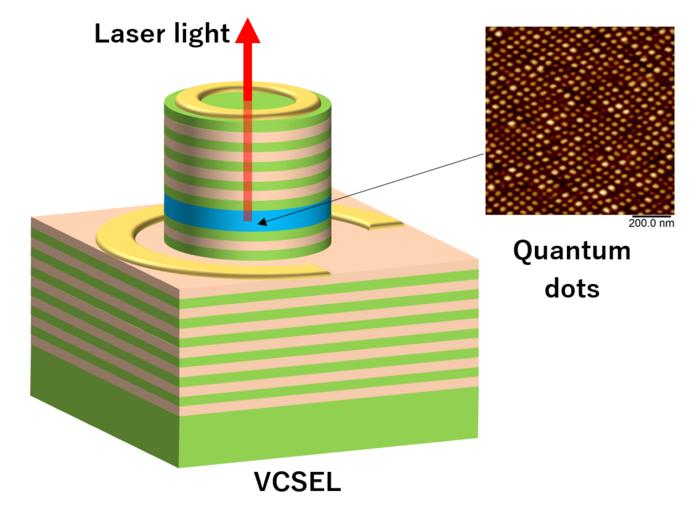Reviewed by Lexie CornerJun 9 2025
In collaboration with Sony, the National Institute of Information and Communications Technology developed an electrically driven VCSEL that operates at 1,550 nm. This is the standard wavelength used in optical fiber communication. The device uses nanoscale semiconductor structures called quantum dots as the optical gain material.
 Schematic of a surface-emitting laser and quantum dots. Image Credit: National Institute of Information and Communications Technology (NICT)
Schematic of a surface-emitting laser and quantum dots. Image Credit: National Institute of Information and Communications Technology (NICT)
Highlights
The National Institute of Information and Communications Technology, in collaboration with Sony Semiconductor Solutions Corporation (Sony), has developed a practical surface-emitting laser that uses quantum dots (QDs) as the optical gain medium. This laser is intended for use in optical fiber communication systems.
The achievement was made possible through NICT’s precision crystal growth techniques and Sony’s advanced semiconductor processing technologies. The laser uses nanoscale semiconductor structures, known as quantum dots, as light emitters.
This development supports the miniaturization and reduced power consumption of light sources in fiber-optic communication. It also offers potential benefits in manufacturing, such as lower production costs through mass fabrication and increased output through device integration.
Background
Modern communication systems require high-capacity data transmission with low power consumption. Vertical-cavity surface-emitting lasers (VCSELs) are being explored as a key technology to meet these demands, especially in optical communication. However, most VCSELs operate in the near-infrared range, typically at wavelengths of 850 or 940 nm.
Developing VCSELs that operate at longer wavelengths, such as 1,550 nm - commonly used in modern optical fiber communications - presents several technical challenges. These include complexities in material selection and structural design. Achieving good output and efficiency at 1,550 nm also depends on the development of effective light-emitting materials and device structures.
To address this, NICT developed a core technology: a high-precision crystal growth method for compound semiconductors using molecular beam epitaxy. Constructing a VCSEL requires a highly reflective semiconductor multilayer film, known as a distributed Bragg reflector (DBR), to enhance light intensity. However, creating DBRs that function efficiently at 1,550 nm has been difficult due to the limited combination of usable materials.
In this study, researchers developed a method to precisely control the component ratios during crystal growth. This allowed them to create a semiconductor DBR with reflectivity exceeding 99 % at 1,550 nm.
Additionally, they used strain-compensation techniques during VCSEL fabrication. These techniques canceled the internal strain that normally forms around the quantum dots. As a result, the density of quantum dots increased, and light emission performance improved.
Sony contributed to the second core technology: a design and manufacturing approach that enables efficient current injection. This was achieved through a structure called a tunnel junction. In typical VCSELs, light is emitted perpendicular to the wafer surface. However, conventional electrode arrangements can block this light, even when quantum dots emit it.
By combining both technologies, the team successfully created a VCSEL that uses quantum dots to emit light at 1,550 nm. The device achieved lasing with a low current of just 13 mA. Polarization fluctuations were also minimized, resulting in stable output.
VCSELs that use quantum dots as the optical gain medium offer good temperature stability. They also support scalable designs, making mass production possible. These features could help improve performance, reduce manufacturing costs, and boost output for lasers used in optical communication systems.
Future Prospects
The researchers plan to conduct advanced technical studies on quantum-dot-based VCSEL technology to increase data capacity and reduce power consumption in optical fiber communication networks beyond the 5G era. At the same time, they aim to promote the practical adoption of this technology in society.
Journal Reference:
Shiomi, M., et al. (2025) Electrically pumped laser oscillation of C-band InAs quantum dot vertical-cavity surface-emitting lasers on InP(311)B substrate. Optics Express. doi.org/10.1364/OE.551300